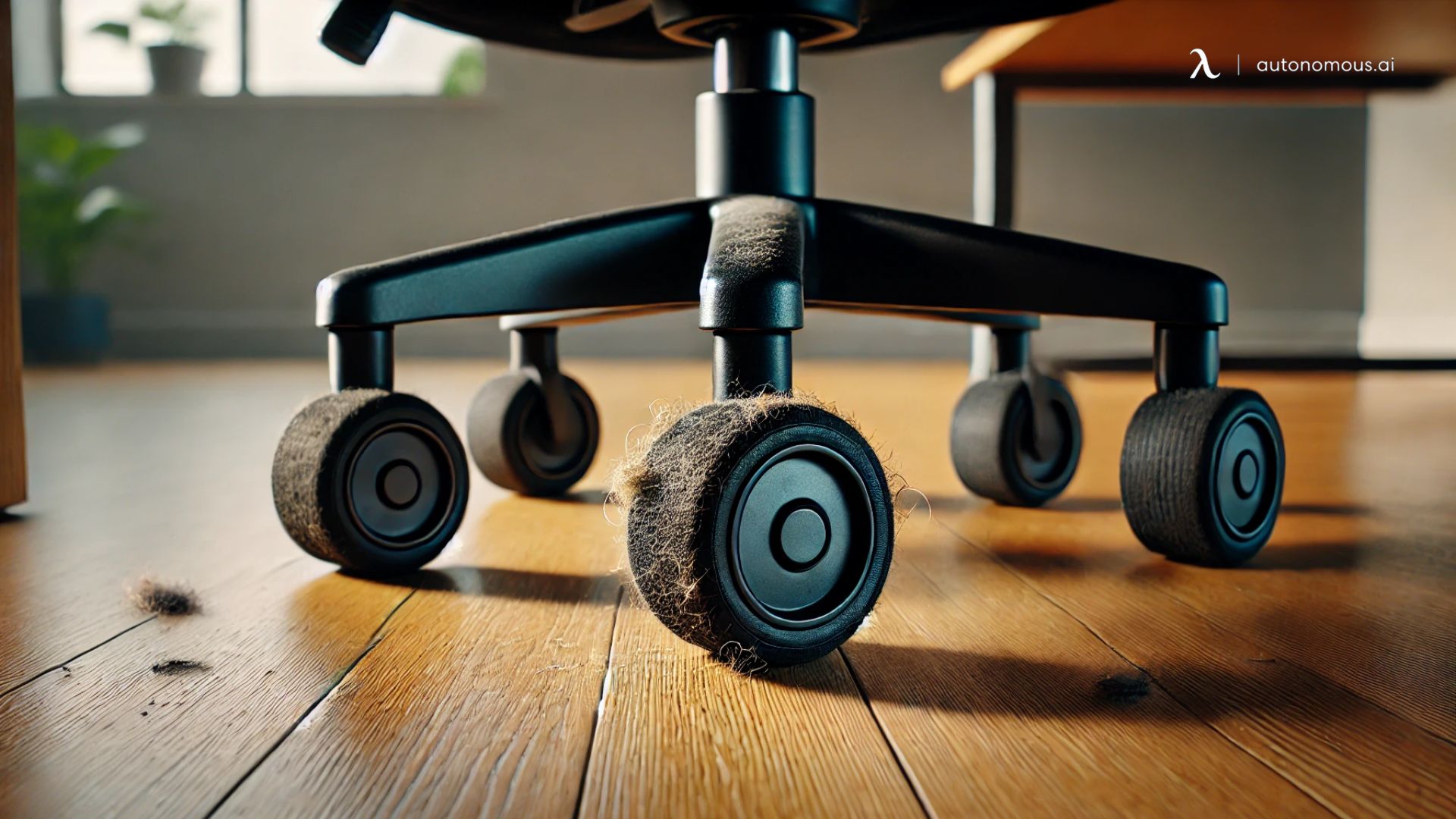
How to Remove Hair That is Stuck in Your Office Chair Wheels
Table of Contents
Dirt happens. Over time, things get dirty, dirt and dust accumulate, and clumps of dirt gather in corners and under shelves that no one looks at. Even if you clean every day, dust and dirt are always accumulating.
This can be very apparent in an office chair. Over time, your wheels will grow harder and harder to move. You might think it’s lubrication wearing out, and it might be, but another potential cause is hair.
That’s right; hair builds up in chair casters. Running over a piece of hair doesn’t seem like much – you would never notice it even if you were paying attention to it – but the combination of dirt and static electricity can suck that hair right into the wheel.
Of course, a single hair, or even a dozen hairs, isn’t going to do much to your wheel. It might get caught in the sticky grease that keeps the wheel turning, or it might snag on the carpet or a sock and come loose right away.
Slowly over time, hair can accumulate in the wheels of your chair. It’s even more prominent if you or a family member (or coworkers, in the office) have longer hair. It’s also apparent if you have long-haired pets who shed.Pet hair, human hair, any hair - it’s all the same to the wheels of yourchair.
Unfortunately, there’s no truly easy way to remove this build-up of hair. There are a lot of different methods you can try, but almost all of them involve flipping the chair over and manually removing the hair.
Preparing to Clean Chair Wheels
The first thing you should do to help with your cleaning is to remove the wheels from your chair. The vast majority of chairs have removable casters, though it might take some significant leverage to pry them loose. Being able to hold the casters in hand and work at a table is better than flipping a chair over and working from the floor, particularly if you have back pain issues or other problems.
Some office chairs don’t have removable casters, which makes themmore difficult to handle. You can flip the chair over and, while sitting in another chair, balance it on its back. You may need to remove any headrests from the chair for this to work. Alternatively, grab a pillow or something comfortable to sit on, and settle in on the floor. This will likely take a while to clean your wheels, depending on the method you use.
If you need to access the base for a more thorough cleaning or to replace it, you’ll need to remove the office chair base. Start by unscrewing any bolts or clips that secure the base to the chair. Once removed, you can clean or replace the base as needed before reattaching the wheels and reassembling the chair. For a detailed guide on how to remove the office chair base, check out this helpful article on how to remove the office chair base.
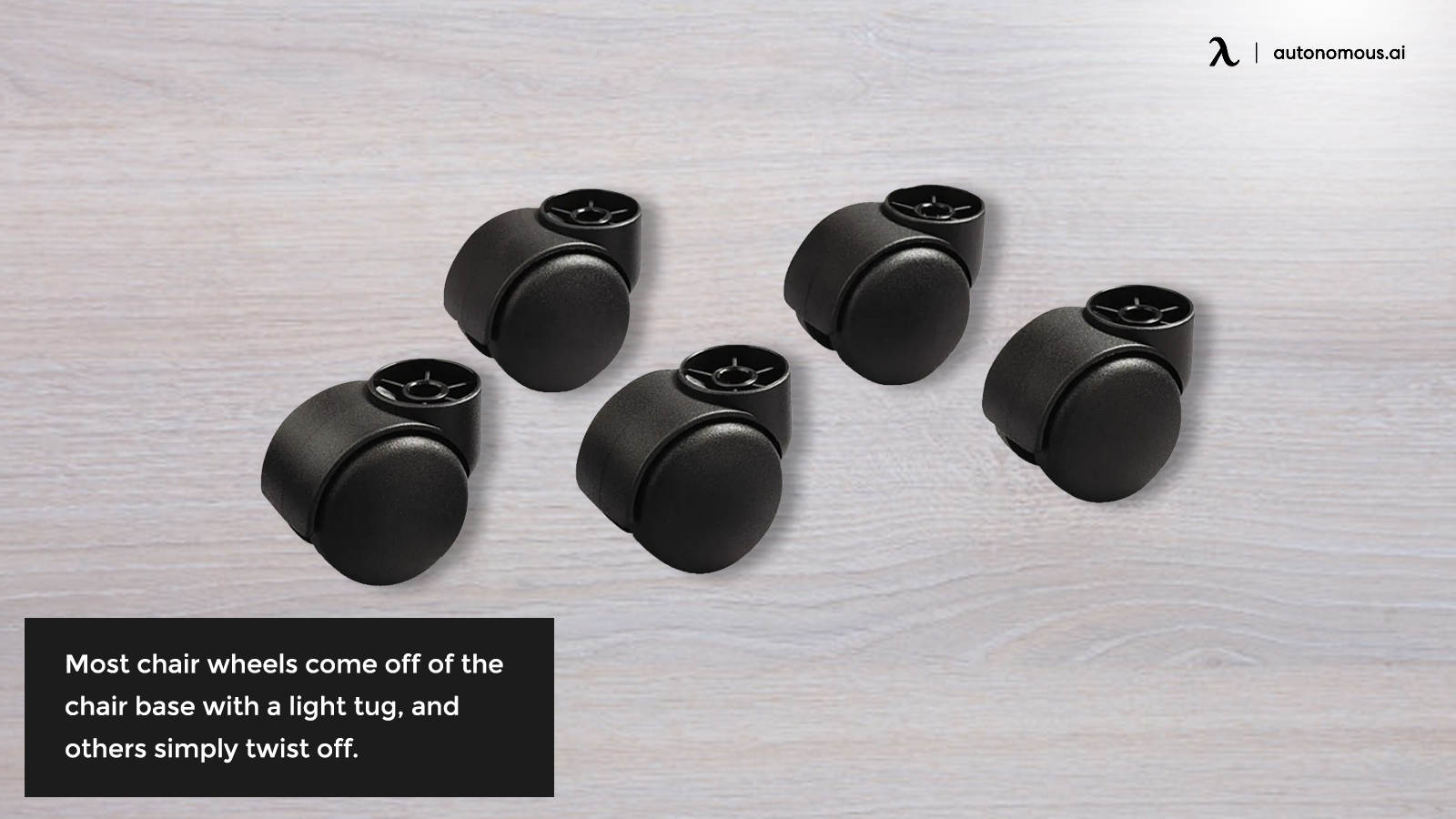
1. Tweezers and Elbow Grease
The first, simplest, and most tedious way to remove the hair from office chair wheels is to pry it out using tweezers. A simple pair of strong tweezers (not the kind you pull out of a swiss army knife) will do fine to grab chunks of hair and pull them out. You’ll probably need to break and tear the hair as you work at it, and this will take quite a while to do the more hair that’s built up, but it’s an entirely doable operation.
If you don’t want to use tweezers, a good pair of thin needle-nosed pliers can also work - anything that will allowyou to reach into a narrow space, grip something, and pull it out will work here. Your goal is simply to grab small amounts of hair at a time and tug to remove them. You don’t need to put a ton of effort into it, but wiggle back and forth to loosen the strands. The more hair you remove, the easier the rest of it will be to remove.
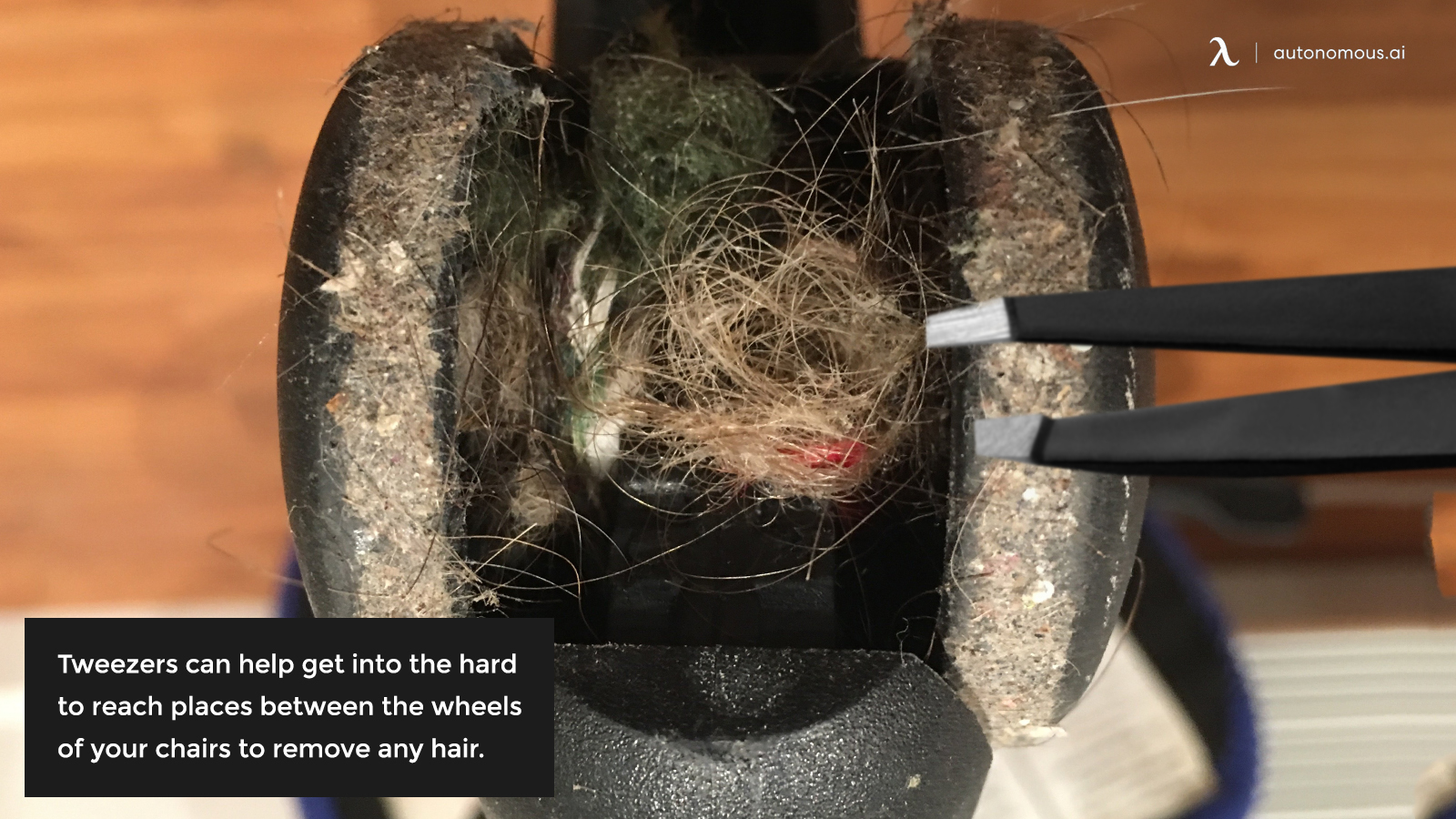
2. Duct Tape on a Stick
Another method many people use online is to use a bit of duct tape, or another strong adhesive tape, wrapped around the end of something thin like a razor blade or spudger. The adhesive of the tape will stock to some of the hair and, when you remove it, will pull the hair out with it.
This method mostly works as a mid-way clean-up or as a secondary method to get the rest of the hair out, once you’ve removed most of it using other methods. Why? Because the hair will be pretty well stuck in place if it’s all long and wrapped around the axle of the caster. Duct tape will cling to it, but won’t have the adhesive strength to remove it. You’ll get some, but trying to remove all of the hair this way will be an exercise in frustration.
3. Crochet Hook or Hooked Needle
Anything with a small enough hook on it can reach under clumps of hair and pull to remove it. There are several different ways you can do this. A small crochet hook allows you to catch loops of hair and pull them loose, and either remove them or grab them with tweezers to further pull to remove them.
A simple needle and thread will allow you to weave a loop around the hair and pull to remove it. Be careful using this method, though, as if it doesn’t work, you’ll end up with hair and thread stuck in your chair wheels, and that’s no good for anyone.
Even something like a fish hook can work to hook and remove hair from a wheel. They’re small, they’re sharp, and they can work under the hair to remove it from a small, enclosed space. Of course, a fish hook is very sharp and usually barbed, so you want to be careful not to stab yourself with them.
Another option is a dental pick. Dental kits can be purchased for around $10, and a pick is a long, thin, stiff, hooked piece of metal. It should do the trick nicely.
4. Drain Cleaner
Drains in showers and sinks often clog up, due to the build-up of many things, including hair. Thus, many drain cleaners are powerful caustics that can dissolve hair entirely. Simply fill a bucket or tray with the cleaner (diluted or not, according to the instructions) and leave the casters in it to soak for a few hours. With any luck, the hair will have mostly or completely dissolved in that time. Remove the casters and rinse them off.
As a bonus, you can then “re-use” the drain cleaner by pouring it down your drains!
When working with any sort of caustic chemical like drain cleaner, be very careful to handle it properly. Use it in a well-ventilated area or outdoors, and don’t submerge your hands in it. Use something like tongs to retrieve the casters, or wear gloves while doing it, and rinse them off thoroughly before putting them back on your chair.
5. Razors or Scissors
If there’s a lot of hair built up into your casters, or it’s proving very stubborn and difficult to remove, you can use something sharp to cut through it. The plastic of the wheels might get a little scratched up, but that won’t affect how well it works, and the axle is metal and will be fine.
Simply take something long and sharp, like a pocket knife, a razor blade, or a box cutter (Stanley knife), and slice across the hair repeatedly to cut it. As you cut chunks of hair, use something like tweezers or pliers to grab those chunks and pull them out. This will be a lot easier than pulling at it normally, but it’s slightly dangeroussince you’re working with a sharp blade. Be very careful not to cut your hands or anything you’re resting the casters on while you work.
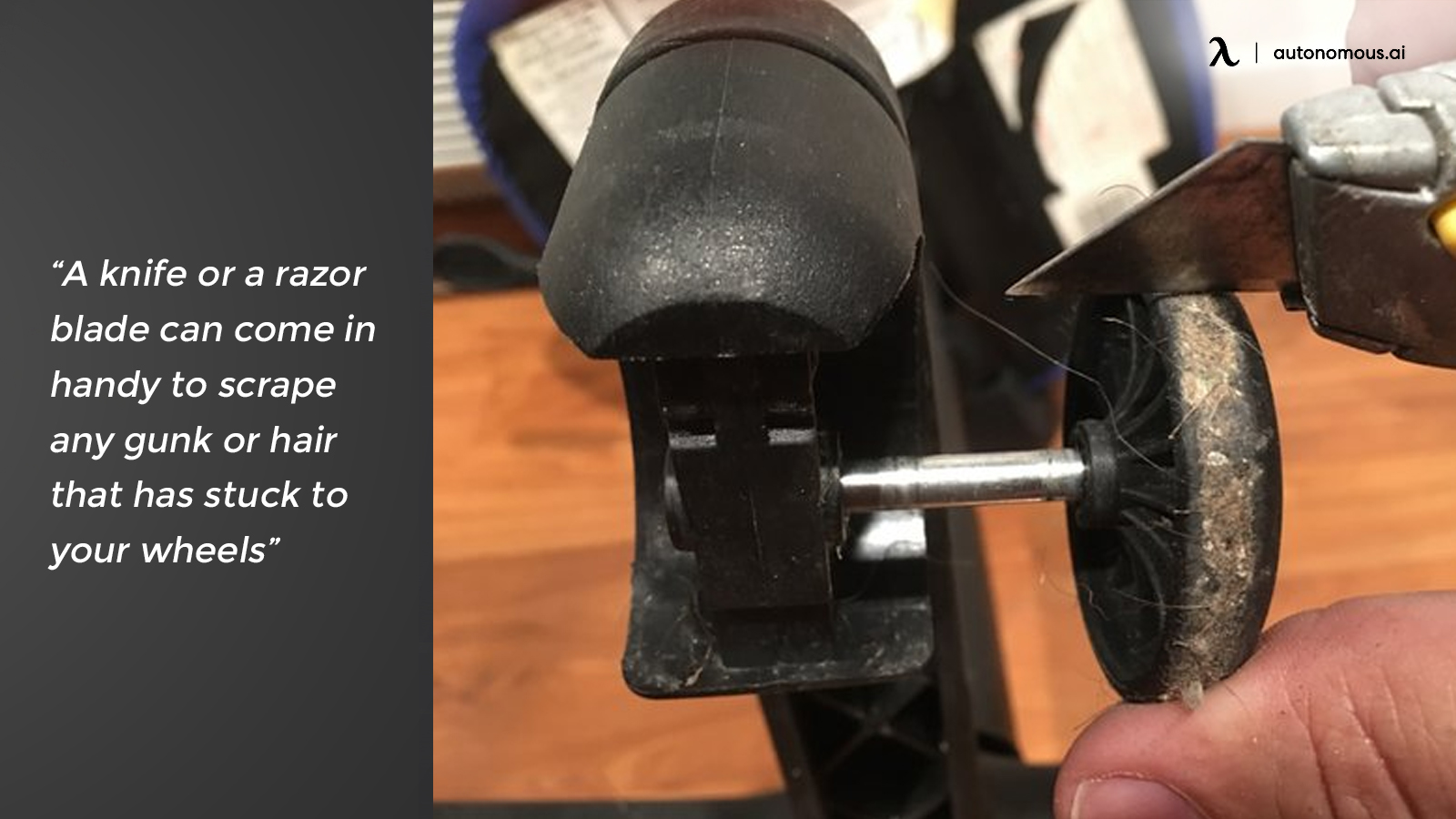
6. Ready, Aim, Fire!
Believe it or not, one of the simplest ways to clean the hair out of chair wheels is to use fire. Various people recommend different kinds of fire; a blowtorch, a lighter, or a heat gun can all work. Hair is usually coated in a thin layer of oil and is itself very flammable, so it will curl up and burn very, very quickly.
There are a lot of cautions for this method. Burning hair stinks, so do this outside. Be very careful with fire so you don’t burn yourself or light anything else on fire. Keep a bucket of water or a fire extinguisher nearby.
Additionally, while hair burns much faster than the plastic of your chair wheels, a sufficiently hot torch can damage the wheels if you let it linger too long. Be quick and use short bursts of flame, rather than a sustained burn. You only want the flame lit for a split second to burn the hair, without burning any plastic or damaging your chair.
7. Disassemble the Wheels
A final option might be simply disassembling the casters to remove the clumps of hair all at once. Many casters are simply plastic discs pressed into the sides of a metal axle; using the right kind of leverage or a spreader, you can pry the plastic side right off. Once the wheel is off, you can slide the nest of hair off and replace the wheel.
The reason this “simple” solution is the last one on our list is because of the possibility ofdamage. Removing the wheel of a caster may or may not even be possible. Some casters are formed and sealed, and removing the wheel will break it. Older wheels can grow brittle and might snap when you try to remove them. There’s a lot of potential for damage here, and if you fail, you’ll need to buy new casters anyway.
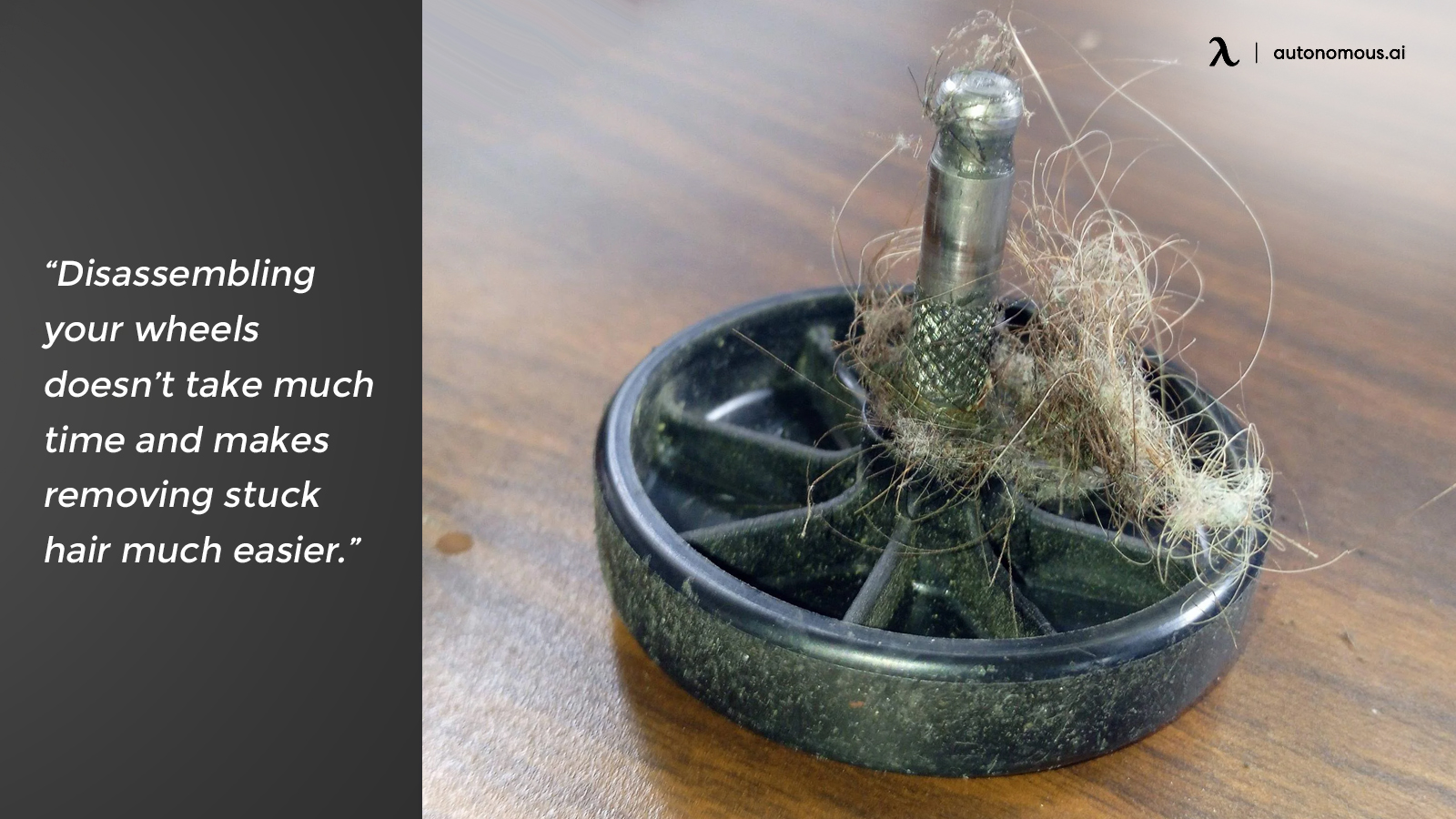
Post-Hair-Removal Cleaning and Maintenance
Once you’ve removed all (or just most) of the hair from your wheels, you should make an effort to clean and repair the casters as necessary to get more life out of them. This involves several steps.
First, use soap and water. If your casters are removable, then put them in a bowl or a bucket of warm soapy water and let them soak for a while. Stir them up and remove them. This helps remove any additional dirt, grime, and hair still caught in the wheels. If you can’t remove the casters, a large, shallow tray can serve the same purpose. All you need is something deep enough to submerge the wheels.
Next, align the wheels of the casters if necessary. Casters turn smoothly when both sides of the wheel are evenly spaced away from the central hub. You can often simply adjust this with your fingers, though a pry bar or screwdriver might be necessary to exert enough force side to side.
Once your wheel is in place, use a lubricant to smooth out its motion. A penetrating oil or a silicone lubricant will do just fine. Remember that plain old WD40 isn’t a lubricant, but the WD40 brand makes lubricants you can use, so make sure to get the right stuff.
Finally, you will want to clean your office area to prevent this from happening again. Vacuum your carpet thoroughly, and repeat once a week to get as much stray hair as possible. Additionally, using a chair mat can help a lot.
![]()
Final Option: Replace the Wheels
If all else fails, or you’ve read through this entire post and just don’t want to clean these dinky plastic wheels, you’re in luck. Casters are one of the easiest and simplest parts to replace on most office chairs. Unless your chair has casters built into them – which is quite rare – you can remove the casters with a pry bar and replace them. Be careful not to damage the base of the chair itself while doing this, but if you’re replacing them anyway, you don’t have to worry about damaging the casters as you remove them.
We recommend rubber wheels over traditional casters in most cases. They’re much smoother, harder to clog up, and may even have built-in brakes to help keep you in place with their movement. The only downside is they’re a bit taller, so you may need to adjust the height of your chair to suit your ergonomics. You can also try something like glides instead. These work great on low-pile carpetsbut have a harder time on hard surfaces, on deep carpets, or on chair mats.
If you’ve chosen to replace your casters instead of trying to clean your existing wheels, here’s a guide on how to do it.
If you're tired of this happening to your wheels on a regular basis, or if you're simply considering a new chair, we encourage you to check out the ErgoChair. You won't regret it.
.svg)







